Everything You Need to Know About Computer Hardware
Welcome to our comprehensive guide on “Computer Hardware” Whether you’re a tech enthusiast, a student with a thirst for knowledge, or simply curious about the inner workings of computers, this article is your ultimate resource. We’ll take you on a journey from understanding the fundamental components of a computer system to exploring advanced hardware configurations. Get ready to familiarize yourself with essential terms like CPU, GPU, RAM, motherboard, and storage, while also delving into exciting topics such as overclocking, cooling solutions, and compatibility issues. Our goal is to demystify the world of computer hardware and equip you with the knowledge to make well-informed decisions when it comes to building or upgrading your own system.
What is Computer Hardware?
ad
The hardware of a computer system is a collection of physical components that play an important role in its operation. This wide category includes all tangible components that contribute to the operation of the computer. Various types of hardware are included inside a desktop or a laptop PC, albeit with changes in size and type due to the small design of laptops. Despite these distinctions, both desktops and laptops rely on critical hardware components to enable correct operation.
Computer Hardware Components
Computer hardware is composed of several essential components that work together to enable the functionality of a computer system. These components include:
- Motherboard
- Central processing unit (CPU)
- Random access memory (RAM)
- Storage drive (HDD or SSD)
- Graphics processing unit (GPU)
- Keyboard, mouse, & monitor
ad
What is a Motherboard?
A motherboard, often known as a mainboard or system board, is a fundamental component of computers and other electronic devices. As the central hub, it facilitates communication and connectivity among diverse hardware components, allowing them to work as a cohesive system.
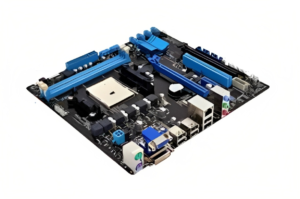
Some of the vital functions of a motherboard include:
- CPU Socket: This is where the processor is mounted, establishing the necessary electrical connections for the CPU to interact with other components on the motherboard.
- RAM Slots: These slots hold the memory modules (RAM) that provide temporary storage for data and actively used programs.
- Expansion Slots: These slots enable the installation of additional expansion cards to enhance the system’s capabilities, such as dedicated graphics cards or sound cards.
- Storage Connectors: The motherboard has connectors like as SATA ports for attaching hard drives and SSDs, as well as M.2 slots in some cases for speedier NVMe-based storage.
- BIOS/UEFI Chip: The Basic Input/Output System (BIOS) or Unified Extensible Firmware Interface (UEFI) chip contains firmware that initializes the hardware during startup and provides essential instructions to the operating system.
- Connectors and Headers: The motherboard features various connectors for USB, audio, networking (Ethernet), and other peripherals.
- Power Connectors: These connectors deliver power from the power supply unit to the motherboard and its components.
The motherboard’s size and form factor (such as ATX, MicroATX, Mini-ITX) dictate its physical dimensions and layout, influencing the number of components and expansion options it can support. A well-chosen motherboard is fundamental to building a reliable and powerful computer system.
What is a Central Processing Unit (CPU)?
The Central Processing Unit (CPU) is the primary component of a computer that performs most of the processing and calculations necessary to execute instructions from software programs. It is often considered the “brain” of the computer, as it controls and coordinates the operations of various hardware components to carry out tasks requested by the user or running programs.
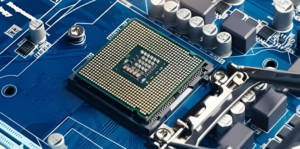
The primary functions of a CPU include:
- Fetch: The CPU retrieves instructions from the computer’s memory, one by one, in a sequence determined by the program being executed.
- Decode: The CPU decodes the instructions, breaking them down into a series of simpler operations that it can understand and execute.
- Execute: The CPU performs the actual computations or operations specified by the decoded instructions. This could involve arithmetic calculations, logical comparisons, data movement, and more.
- Store: After executing the instructions, the CPU may store the results back into memory or update the values in the registers, which are small, high-speed memory storage locations within the CPU.
The speed at which the CPU can execute instructions is based on the clock cycle, a definite unit of time. The speed of the CPU is measured in Hertz (Hz) or its multiples, such as megahertz (MHz) or gigahertz (GHz), representing the number of cycles it can perform per second.
Modern CPUs are designed with several cores, enabling them to handle several tasks at once. The term “multi-core processors” is used to describe them. Additionally, CPUs often have features like caching, pipelining, and instruction set extensions to optimize performance and efficiency.
What is Random Access Memory (RAM)?
Random Access Memory (RAM) is a type of computer memory that provides temporary storage for data and instructions that the CPU needs to access quickly while a computer or other electronic device is running. It is a crucial element of contemporary computing systems and affects a device’s overall performance and responsiveness significantly.
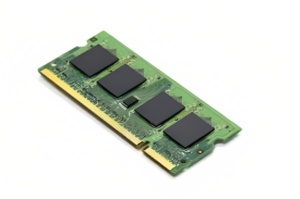
Key characteristics of RAM include:
- Volatile Memory: RAM is volatile memory, meaning its contents are erased when the power to the computer is turned off. RAM does not store data when the system is shut down, in contrast to long-term storage devices like hard drives or SSDs.
- Fast Access Speed: RAM is much faster than storage devices like hard drives or SSDs, enabling the CPU to quickly read and write data during program execution. When compared to obtaining data via storage devices, which can take milliseconds, the CPU can access data in nanoseconds because to this speed.
- Data Storage During Operation: When a program is running, its instructions and data are temporarily loaded into RAM to allow the CPU to access them rapidly. The more data a computer can store in this temporary area, the more RAM it has, which can enhance system speed.
- Dynamic RAM: Most modern RAM is based on Dynamic Random Access Memory (DRAM) technology. DRAM requires periodic refreshing to maintain data integrity, and it stores each bit of data in a separate capacitor within an integrated circuit.
- Memory Modules: RAM is installed in the computer’s motherboard using memory modules such as DIMMs (Dual In-Line Memory Modules) or SO-DIMMs (Small Outline Dual In-Line Memory Modules) in laptops and other smaller devices.
- Memory Capacity: RAM is available in various capacities, ranging from a few gigabytes (GB) to several terabytes (TB) in high-end servers. The amount of RAM in a computer affects its ability to handle multiple applications simultaneously and run memory-intensive tasks efficiently.
Between the CPU and the storage devices, RAM serves as a fast bridge. When you open a program or load a file, it gets temporarily stored in RAM, allowing the CPU to access it quickly during execution. The data stored in RAM is wiped as you exit the program or shut down the computer, making it accessible for future operations.
Read More:- What Computer Formatting Means
What is a Graphics Processing Unit (GPU)?
A Graphics Processing Unit is a specialized electronic circuit or processor designed to accelerate and optimize the rendering of images, videos, and animations. The GPU is primarily designed for graphics-related computations, unlike the CPU, which is a general-purpose processor that handles a variety of activities. As a result, it is extremely efficient for graphical workloads.
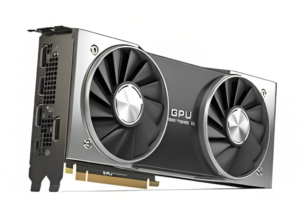
Key features and functions of a GPU include:
- Graphics Rendering: The primary function of a GPU is to render and display graphics on a screen. It transforms the visual data into pixels that may be displayed on the monitor or other display devices after processing the visual data, which includes 2D images, 3D models, textures, and shaders.
- Parallel Processing: Modern GPUs are substantially faster at performing parallel processing tasks than older CPUs because they include thousands of little processor cores that can tackle numerous jobs at once. This parallel architecture is well-suited for graphics-related tasks that require extensive mathematical computations.
- 3D Graphics and Gaming: GPUs are vital components in 3D graphics rendering, which is crucial for video games, computer-generated imagery (CGI), virtual reality (VR) experiences, and other applications that require realistic and immersive visuals.
- Compute Acceleration: Beyond graphics, GPUs can also be used for general-purpose computing tasks, known as General-Purpose GPU (GPGPU) computing. This method makes use of the GPUs’ parallel processing power to quicken operations like data processing, machine learning, and artificial intelligence as well as scientific simulations.
- Video Decoding and Encoding: GPUs often include dedicated hardware for video decoding and encoding, allowing for smooth playback of high-definition video content and efficient video compression.
- Multiple Monitors: Many GPUs support multiple monitor outputs, enabling users to connect multiple displays to a single GPU for expanded desktop space or multi-monitor gaming setups.
- Gaming Performance: The GPU is a key component in influencing the frame rates and graphical quality of games in the gaming context. Gamers desire high-performance GPUs for smoother and more aesthetically pleasing gaming experiences.
GPUs can be integrated into a computer’s motherboard (integrated graphics) or come as separate, dedicated graphics cards that are installed in the PCIe (Peripheral Component Interconnect Express) slots. Dedicated graphics cards are frequently found in gaming PCs, workstations, and other systems that demand extensive graphical processing since they tend to perform better.
What is a Power Supply Unit (PSU)?
A Power Supply Unit (PSU) is a critical component of any computer or electronic device that converts alternating current (AC) power from a wall outlet into direct current (DC) power needed to power the device’s internal components. The power supply unit (PSU) provides the necessary electrical power to all of the system’s physical components, including the motherboard, CPU, GPU, storage devices, and other peripherals.
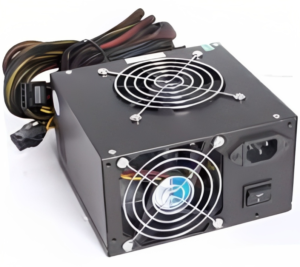
Key functions and features of a Power Supply Unit include:
- Power Conversion: The main function of the PSU is to convert the AC power from the electrical outlet (usually at 110-120V or 220-240V, depending on the region) into the DC power required by the computer’s components. This DC power typically ranges from +3.3V, +5V, +12V, and sometimes -12V and -5V.
- Wattage and Power Rating: PSUs come with different power ratings, typically measured in watts (W). The wattage indicates how much power the PSU can deliver to the components. For systems with more potent and powerful components, like gaming PCs or workstations, higher wattage PSUs are necessary.
- Connectors: The PSU provides various connectors and cables to supply power to different components in the computer. The 4-pin or 8-pin CPU power connectors, SATA power connectors for storage devices, and PCIe power connectors for graphics cards are all common. ATX connectors are used for motherboards.
- Efficiency: PSUs are rated for their efficiency, which is the percentage of power drawn from the wall outlet that is effectively converted into usable DC power for the components. Higher efficiency ratings mean less power is wasted as heat and can lead to a more energy-efficient and cooler-running system.
- Modularity: Some PSUs come with modular cables, allowing users to connect only the cables they need. This feature reduces cable clutter inside the case and can lead to better airflow and easier cable management.
- Overcurrent and Overvoltage Protection: Good quality PSUs have built-in protection mechanisms to safeguard the components from damage due to excessive currents or voltages. These protections help prevent damage in case of power spikes or other electrical issues.
For the overall stability and longevity of a computer system, a dependable and high-quality power supply is essential. Inadequate or low-quality power supplies can lead to system instability, crashes, or even component damage.
What is Storage Drive (HDD or SSD)?
A storage drive, whether it’s a Hard Disk Drive (HDD) or a Solid-State Drive (SSD), is a crucial component of a computer or electronic device used to store and retrieve data. The operating system, software applications, documents, music, videos, and other sorts of data are among the many types of data that can be permanently stored on these drives.
Here’s a brief overview of both types of storage drives:
Hard Disk Drive (HDD):
![Hard Disk Drive (HDD)]() HDDs have been the traditional storage option for computers for many years. They use magnetic storage to store data on spinning platters.
HDDs have been the traditional storage option for computers for many years. They use magnetic storage to store data on spinning platters.- Inside an HDD, an actuator arm with read/write heads moves across the spinning platters to access and modify data. The physical movement of the heads causes some mechanical delays, leading to slightly slower data access times compared to SSDs.
- HDDs are a cost-effective option for bulk storage requirements since they offer higher storage capacities at a lower price per gigabyte compared to SSDs.
- However, HDDs often have slower data read/write rates, which can affect the responsiveness of the entire system and boot times.
Solid-State Drive (SSD):
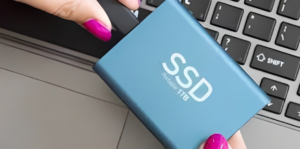
- SSDs are a newer storage technology that has gained popularity due to their much faster performance and dependability when compared to HDDs.
- SSDs store data using NAND flash memory, which has no moving parts. SSDs are more durable and less prone to physical harm from drops or shocks due to the lack of mechanical parts.
- SSDs may provide faster data access and transfer speeds because there are no mechanical delays, which reduces boot times and speeds up application loading.
- The cost of SSDs has declined over time, making them more affordable for many customers even though they are often more expensive per gigabyte than HDDs.
- To balance performance and storage capacity, most current computers and laptops now include SSDs or a combination of SSDs and HDDs (hybrid storage configurations). To take advantage of the speedier SSD, the operating system and regularly used apps are frequently placed on it, while larger files and data are stored on the HDD.
What is Keyboard, Mouse, & Monitor?
Using a keyboard, mouse, and monitor with computers and other electronic devices is vital for facilitating user interaction and providing a user interface for a variety of tasks. Let’s take a closer look at each of them:
Keyboard:

- A keyboard is a type of input device that allows users to enter text, numbers, and commands into a computer or other electronic device. A set of keys, containing letters, numbers, symbols, and special function keys, make up most keyboards.
- Keyboard layouts vary, with the most prevalent being the QWERTY layout. Regional variations with diverse character sets exist for languages other than English.
- Modern keyboards may have multimedia keys, programmable keys, backlighting, and ergonomic designs for comfort during extended use.
Mouse:
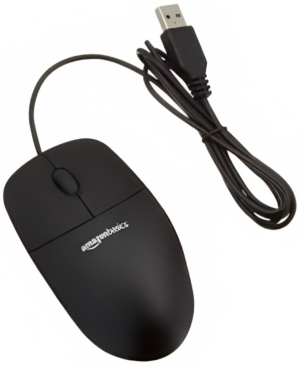
- A mouse is a pointing device that allows you to move the cursor on your computer screen and interact with graphical user interfaces. Users can choose, click, drag, and modify things on the screen.
- Traditional mouse are equipped with two buttons (left and right click) as well as a scroll wheel. More complex mouse may include more buttons, sensitivity settings, and functions such as thumb buttons for gaming or productivity tasks.
- Mice come in wired and wireless varieties, with wireless mice connecting via Bluetooth or USB dongles.
Monitor:

- A monitor, also known as a display or screen, is an output device that visually presents the information processed by the computer’s CPU and GPU.
- Monitors come in various sizes, resolutions, and technologies. Full HD (1920×1080), Quad HD (2560×1440), and Ultra HD/4K (3840×2160) are the most common display resolutions.
- LCD (Liquid Crystal Display), LED (Light-Emitting Diode), OLED (Organic Light-Emitting Diode), and other monitor technologies are available.
- The refresh rate and response time are important specifications for monitors, especially for gaming and fast-paced applications, as they impact how smoothly the screen displays motion.
FAQ’s
What is computer hardware?
The physical parts of a computer system that are necessary for its operation are referred to as computer hardware. The motherboard, CPU, RAM, storage devices (HDD or SSD), GPU, keyboard, mouse, and monitor are among these parts.
What are the main components of a computer system?
The motherboard, CPU, RAM, storage devices (HDD or SSD), GPU, keyboard, mouse, and monitor are the primary parts of a computer system. Together, these parts make it possible for the computer to function.
What does the motherboard do?
The motherboard, sometimes referred to as the mainboard or system board, serves as the primary node that enables connectivity and communication between different hardware parts of the computer. The CPU, RAM, storage disks, and expansion cards can all be connected to it electrically.
What is the role of the CPU in a computer?
The Central Processing Unit (CPU) is considered the “brain” of the computer. It performs most of the processing and calculations necessary to execute instructions from software programs. The CPU controls and coordinates the operations of various hardware components to carry out tasks requested by the user or running programs.
How does RAM impact a computer’s performance?
Random Access Memory (RAM) is a kind of computer memory that offers short-term storage for information and commands that the CPU needs to access rapidly while the computer is operating. Having enough RAM enables the CPU to access data quickly, enhancing system responsiveness and performance.
What is the purpose of a GPU in a computer?
An image, video, or animation’s rendering can be sped up and optimized with the help of a graphics processing unit (GPU). For graphically demanding jobs like gaming, 3D rendering, and video editing, it is essential.
What is the significance of a power supply unit (PSU) in a computer?
Direct current (DC) power, which is needed to operate the computer’s internal components, is converted from alternating current (AC) electricity from a wall socket by the power supply unit (PSU). For the computer to run securely and steadily, a dependable PSU is necessary.
What are the differences between HDD and SSD storage drives?
Solid-State Drives (SSD) use NAND flash memory, which has no moving parts, as opposed to Hard Disk Drives (HDD), which use magnetic storage to store data on spinning platters. Compared to HDDs, SSDs are faster and more reliable, although they are frequently more expensive per gigabyte.
Conclusion
understanding computer hardware is vital for tech enthusiasts, students, and anyone curious about computers. This guide covered fundamental components like the motherboard, CPU, RAM, storage, GPU, and peripherals. Armed with this knowledge, you can make informed decisions when building or upgrading your system. Embrace the ever-evolving world of computer hardware and enjoy your journey into the fascinating realm of technology.
ad


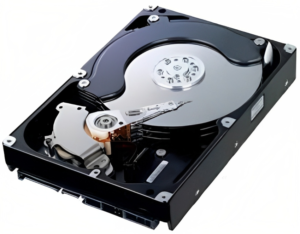 HDDs have been the traditional storage option for computers for many years. They use magnetic storage to store data on spinning platters.
HDDs have been the traditional storage option for computers for many years. They use magnetic storage to store data on spinning platters.
Comments are closed.